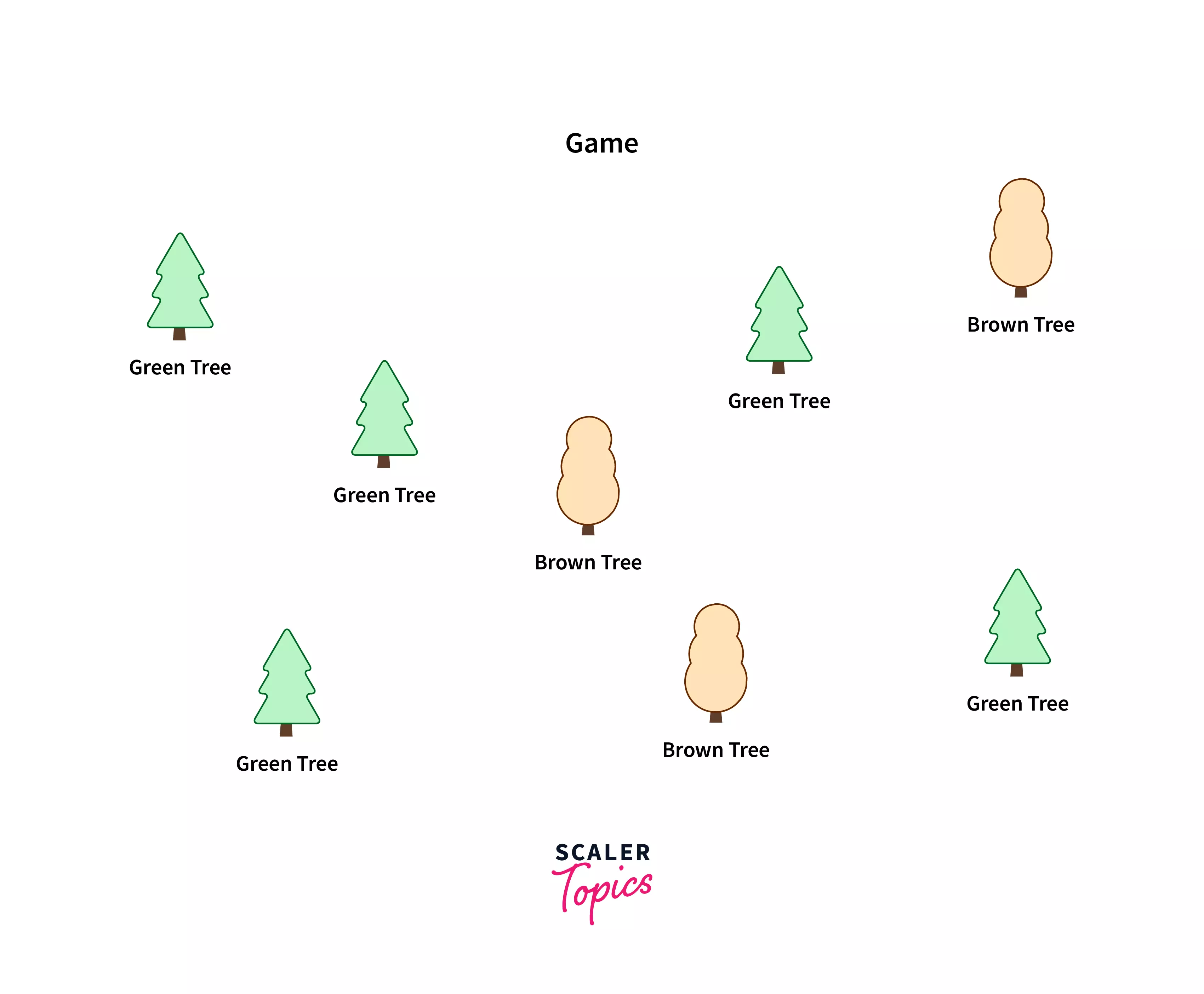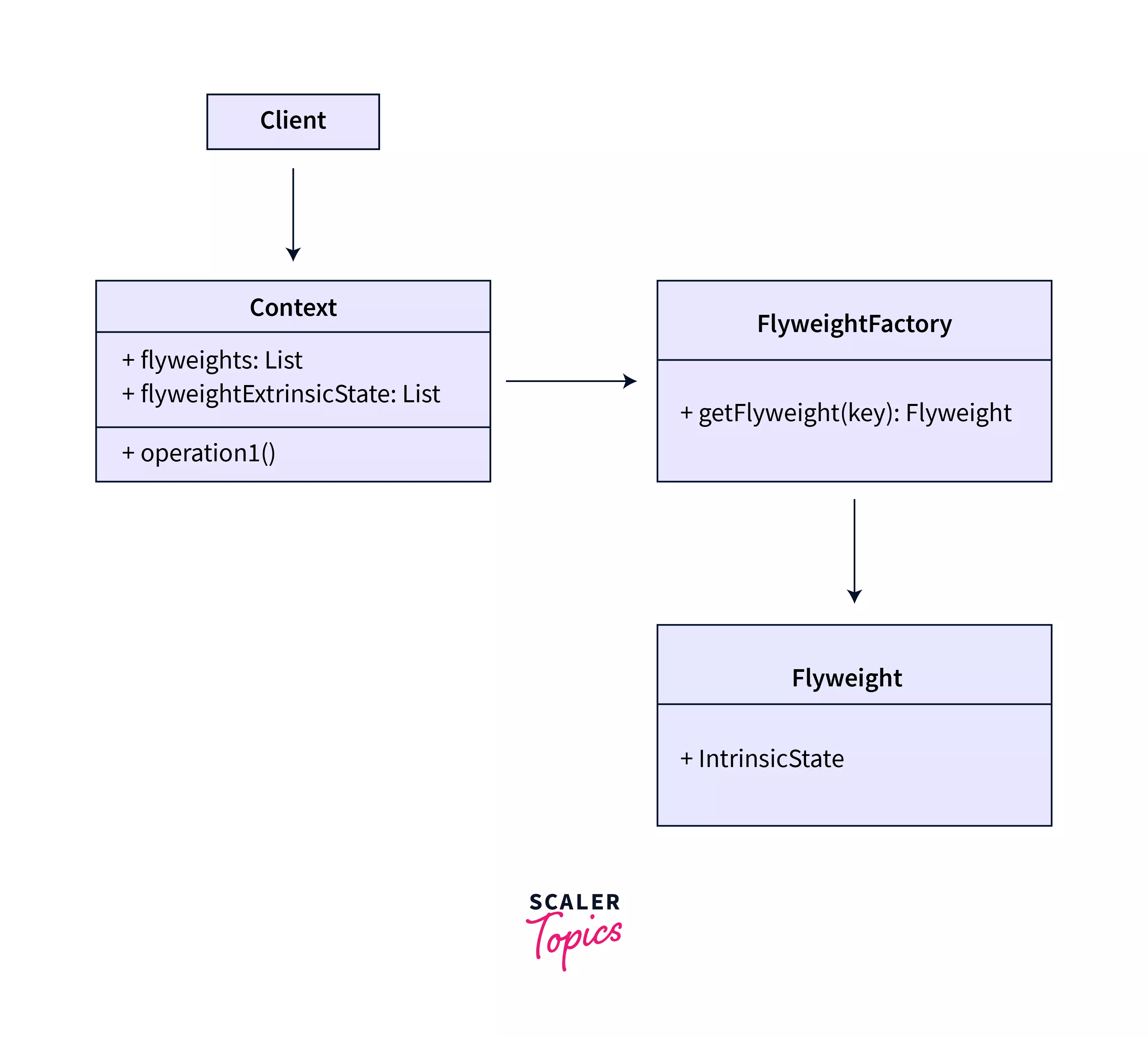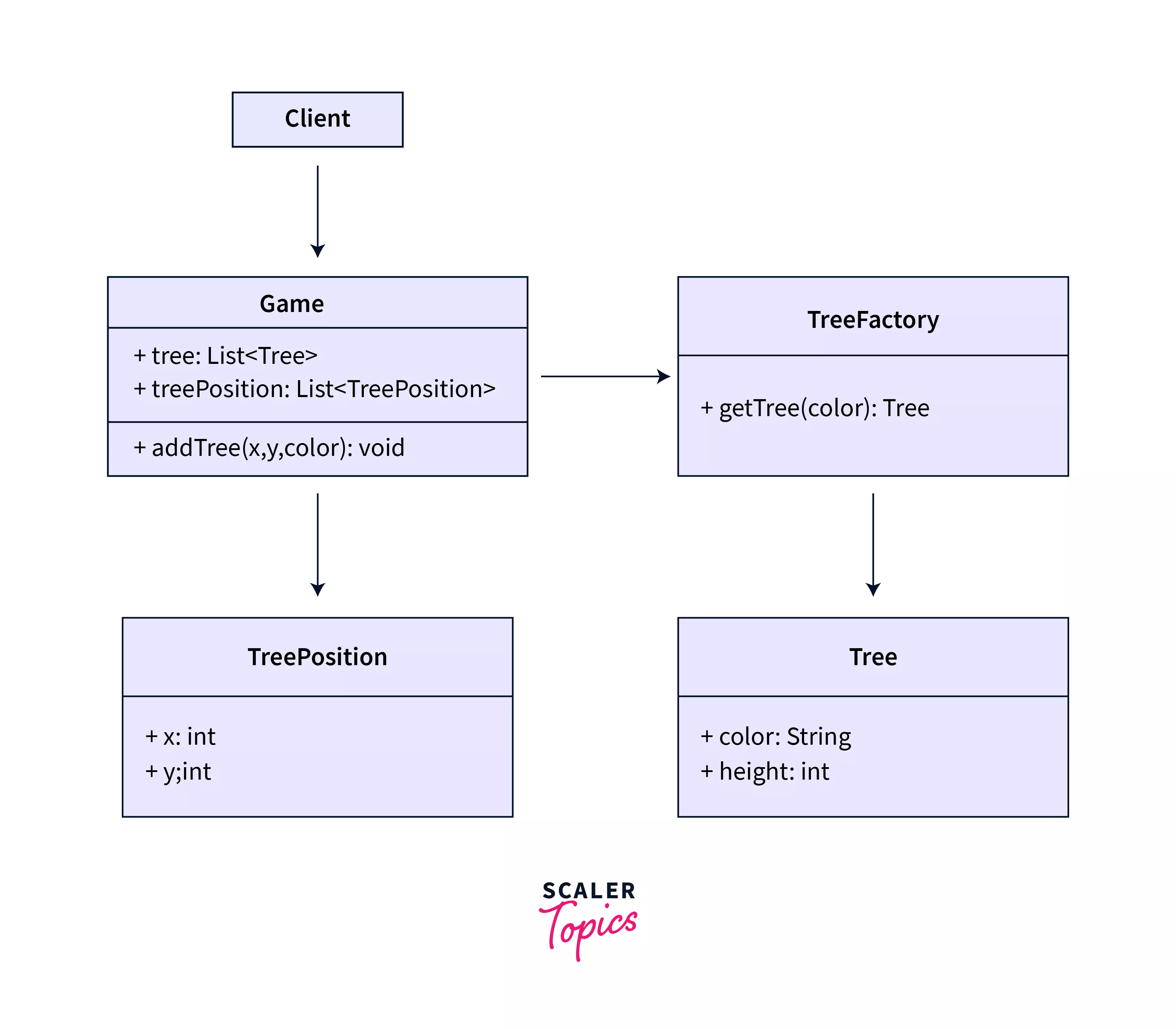Flyweight Design Pattern
Overview
Flyweight design patterns are structural design patterns that help to reduce the memory usage when creating numerous objects by sharing their common states.
When will we Need the Flyweight Design Patterns?
Consider we are creating an open-world game where we need to place a lot of trees for decorative purposes.
The trees are either in green or brown color with a height of6ft. A Tree object has the below three attributes.
- color - The color of the tree. Either green or brown.
- height - The heights of the tree is always .
- position - The coordinate of the tree in the game plane.

Let's say we want to place 10,000 trees (green - 5000 and brown - 5000) in the game and find the total memory required to store those Tree objects in the memory.
| Attribute | Size | Reason |
|---|---|---|
| color | 5 bytes | 1 byte for each character in green or brown |
| height | 4 bytes | 4 bytes to store integer |
| position | 2 * 4 = 8 bytes | 4 bytes each to store x and y |
| Total | 17 bytes |
We need a total of to store a Tree object in memory. So we need bytes ( KB) to store Tree objects in the memory. But if we look closely, we are storing the same colors and height in all the objects; we are wasting a total of 90 KB (color - 50 KB and height - 40 KB) to store duplicate values. The only data varies across the Tree objects in position.
The flyweight design patterns help to eliminate this unwanted space by storing the shared states (color and height) within the Tree object and the unshared states (position) outside the Tree object. The Tree object is called the Flyweight object.
How does Flyweight Design Pattern Work?
Before working on the flyweight design pattern, we must understand the intrinsic and extrinsic states.
- Intrinsic state refers to the state that belongs to the flyweight object. The intrinsic state is immutable. E.g.: color and height.
- Extrinsic state varies for each object and is stored outside the object. The extrinsic state is mutable. E.g., position
We understand the working on the flyweight design pattern by implementing the example of the above-mentioned trees. We will store the intrinsic states color and height in the Tree object and the extrinsic state position in the TreePosition object.
Structure
The flyweight design pattern has core participants such as Flyweight, FlyweightFactory, Context, and Client.

Flyweight Flyweight class contains the intrinsic states of the objects shared across multiple objects. The intrinsic states are immutable. E.g.: color and height.
FlyweightFactory FlyweightFactory class is responsible for returning the Flyweight object. It caches the flyweight object the first time it is created and returns it for all successive requests. E.g.: TreeFactory.
Context The Context class is responsible for maintaining all the flyweight objects with their extrinsic states.
Client The Client is the main class that uses the Context class to create and store the flyweight objects with their extrinsic states.
Implementation
- Create the flyweight class Tree with the intrinsic states color and height.
- Create the TreePosition class to store the flyweight object's extrinsic state position.
- Create the TreeFactory class with a single method, getTree(String color) that creates the Tree object with the given color. The TreeFactory class maintains an internal cache to store the created flyweight objects.
- Create the Game context class that maintains the flyweight objects and their extrinsic state.
- Create the Client class responsible for creating the Tree objects by passing the extrinsic state position.
Pseudocode

Tree
The Tree is the flyweight class that contains the intrinsic states color and height. The intrinsic states are immutable, so we only have getter methods for color and height.
TreePosition
The TreePosition class maintains the extrinsic state position. The extrinsic state is mutable, so we have both getter and setter methods for position.
TreeFactory
The TreeFactory class creates the Tree object with the given color. It maintains an internal map to cache the created flyweight objects.
Game
The Game class stores and maintains the flyweight objects and their extrinsic states.
Client
The Client class uses the Game instance to add trees with the given position and color.
Output
Explanation
We created two classes, Tree and TreePosition, that store both the intrinsic and extrinsic states. The Game class stores and maintains the Tree flyweight objects and its extrinsic state TreePosition. We used the FlyweightFactory class to create and cache the flyweight objects.
Language Specific Code
Java
Tree
TreePosition
TreeFactory
Game
Client
Output
C++
Tree
TreePosition
TreeFactory
Game
Client
Output
Python
Tree
TreePosition
TreeFactory
Game
Client
Output
Pros and Cons of Flyweight Design Pattern
Pros
- Flyweight design pattern reduces memory usage and increases performance by reducing the number of objects.
Cons
- Flyweight design pattern can increase the time complexity as we store the extrinsic states separately, and it takes additional time to query those states.
- Flyweight design pattern can increase the complexity of the code as we need to add additional logic to store and retrieve the extrinsic states.
Difference between Flyweight Design Pattern and Singleton Design Pattern
| Flyweight Design Pattern | Singleton Design Pattern |
|---|---|
| Flyweight design pattern provides shared instance that can have overridden states | Singleton design pattern provides a single instance of a class for the entire application |
| Flyweight design pattern has both intrinsic (cannot be modified) and extrinsic states (can be modified) | Singleton design pattern has only intrinsic states (cannot be modified) |
| Example: A Car class can have shared attributes (intrinsic) such as color and unshared attributes like registration number (extrinsic) | Example: LoggerService class has only one instance and is shared across applications |
FAQs
Q: What are intrinsic and extrinsic states in flyweight design pattern?
A: Intrinsic states are shared across all the objects, whereas extrinsic states are unique to each object. For example, a red car can have the intrinsic state color and the extrinsic state speed because the color is red for all red cars, but the speed may vary.
Q: How are intrinsic states shared across flyweight objects?
A: We can use a factory class in the flyweight design pattern to create the flyweight objects. The factory class will have an internal cache that stores the first created flyweight object. The flyweight object is returned from the cache for successive requests instead of being created again.
